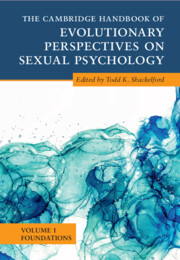Book contents
- The Cambridge Handbook of Evolutionary Perspectives on Sexual Psychology
- The Cambridge Handbook of Evolutionary Perspectives on Sexual Psychology
- Copyright page
- Contents
- Contributors
- Preface
- Part I Foundations of Evolution
- 1 Natural Selection
- 2 Sexual Selection
- 3 Inclusive Fitness Theory
- 4 Adaptive Problems in the Domain of Human Sexuality
- 5 Adaptations, By-products, and Spandrels
- 6 Evolved Psychological Mechanisms
- Part II Middle-Level Theories
- Index
- References
1 - Natural Selection
from Part I - Foundations of Evolution
Published online by Cambridge University Press: 30 June 2022
- The Cambridge Handbook of Evolutionary Perspectives on Sexual Psychology
- The Cambridge Handbook of Evolutionary Perspectives on Sexual Psychology
- Copyright page
- Contents
- Contributors
- Preface
- Part I Foundations of Evolution
- 1 Natural Selection
- 2 Sexual Selection
- 3 Inclusive Fitness Theory
- 4 Adaptive Problems in the Domain of Human Sexuality
- 5 Adaptations, By-products, and Spandrels
- 6 Evolved Psychological Mechanisms
- Part II Middle-Level Theories
- Index
- References
Summary
Human beings are one of the innumerable products of the process of evolution by natural selection. As such, understanding our psychological makeup requires an appreciation of the mechanism of natural selection itself. When a population of reproducing entities has (1) variation in traits, (2) inheritance of variation, and (3) nonrandom differential reproduction, entities with traits that are good at making themselves more numerous will, by definition, tend to be better represented in future generations. Organisms that are best able to interact with their environment in a way that promotes their own reproduction are favored automatically. Under consistent environmental conditions, small changes in inherited traits can add up to complex adaptations by adding incremental improvements to the organisms’ fit with the environment. The relationship between variation and inheritance is complex in organisms because variation is manifest in the phenotype, but inheritance occurs between genotypes. The relationship between these two aspects of organisms is complex because genes must act through interaction with the environment. Further complications arise due to the blindness of natural selection to changes in future environments and available variation. Despite these intricacies, natural selection has crafted vastly complex and diverse organisms over the course of billions of years, with no foresight or thought.
- Type
- Chapter
- Information
- Publisher: Cambridge University PressPrint publication year: 2022



